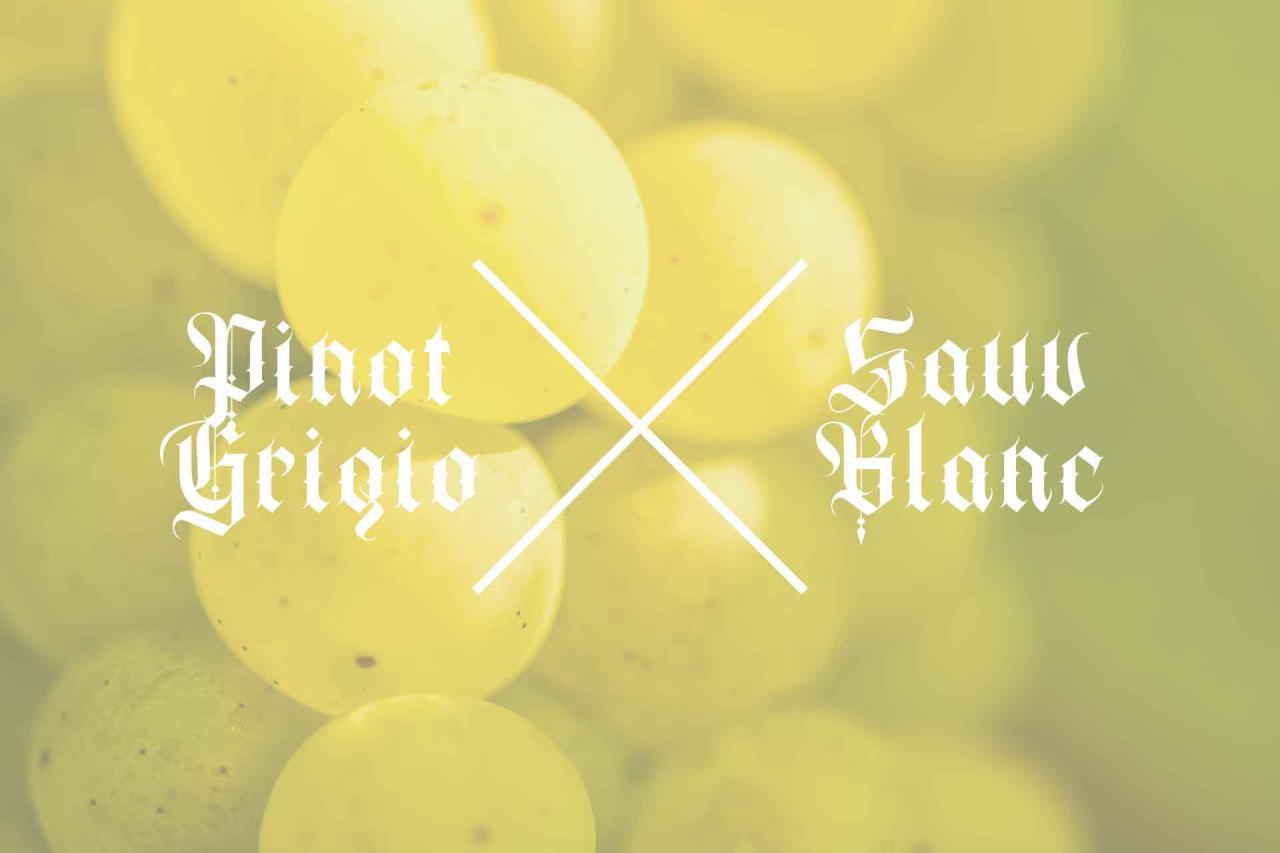Their common characteristics make them particularly popular among consumers, thanks to their freshness, food-friendly, and easily approachable character.
Sauvignon Blanc is a light and refreshing wine with different characteristics depending on the production area. The dry versions reveal citrus and herbaceous notes but also tropical fruit. It is also one of the grape varieties used in Sauternes sweet wines, together with Semillon.
Pinot Grigio also shows interesting differences based on the production area and the style sought by the winemaker. Normally, two main styles of Pinot Grigio are distinguished: the Italian style, fresher and lighter, and the French style (often indicated with the French term Pinot Gris), more aromatic and complex.
To understand which wine best suits your tastes and the food you are serving, today we will analyze the Pinot Grigio vs Sauvignon Blanc comparison.
Pinot Grigio vs Sauvignon Blanc
The answer to the frequently asked question 'is Sauvignon Blanc similar to Pinot Grigio?', in general, is yes. These two grapes have many traits in common, although there are also a few differences in aromas and taste.
Similarities
The winemaking process, as always, may differ from one winery to another, but in general, for the majority of Sauvignon Blanc and Pinot Grigio wines, it involves vinification and aging in cement or stainless steel to preserve the aromatic freshness of the grapes.
Both Pinot Grigio and Sauvignon Blanc are typically dry white wines characterized by aromas of fresh fruit and citrus. Their dryness depends on environmental conditions but Sauvignon Blanc wines tend to taste slightly drier. Nonetheless, they can be both made as sweet wines.
The alcohol content is also very similar, as are the gastronomic affinities with slight differences related to their taste and aromas.
Difference between Pinot Grigio and Sauvignon Blanc
When comparing Pinot Grigio taste vs Sauvignon Blanc, it must be kept in mind that the former generally tends to have a slightly sweeter aroma than the latter, with notes of ripe fruit. Instead, Sauvignon Blanc, that is more aromatic, is characterized by very characteristic herbaceous notes.
The acidic nature and herbaceous aromas of Sauvignon Blanc give it a crispier flavor overall.
Both wines are produced almost everywhere in the world, but while Sauvignon Blanc production is often concentrated south of the equator in regions such as Chile, New Zealand, and South Africa, Pinot Gris is a mainstay of many vineyards in Germany, France, Austria, and Italy.
Comparison chart: Sauvignon Blanc vs. Pinot Grigio
| Pinot Grigio | Sauvignon Blanc | |
|---|---|---|
| Tasting notes | Rich and pungent, with good structure and fruity and floral aromas. | Crisp and mineral with high acidity and greenish flavors. |
| Sweetness | Dry to sweet | Dry |
| Body | Light to medium | Light to medium |
| Acidity | Medium | High |
| Alcohol | Medium | Medium |
| Age worthiness | 2 to 15 years | 2 to 5 years |
| Cost | $8 to $100 | $7 to $150 |
| Food pairing | hearty fish dishes, white meats and salami, Carbonara pasta, Pad Thai. | vegetarian and herb-driven recipes, fish, goat cheese, Vietnamese food |
| Serving temperature | 8-12°C / 46-54° F | 7-12°C / 45–54°F |
Get updates on the latest posts and more from Wine Bugle straight to your inbox.
Pinot Grigio vs Sauvignon Blanc: taste
Pinot Grigio
The character of Pinot Grigio strongly depends on the place and style in which it is produced. In particular, two styles of Pinot Grigio are distinguished. The Italian Pinot Grigio style is a fresh and light wine, while the French style corresponds to more full-bodied and complex wines.
But in general, its aromatic, ethereal, and delicate scent refers to the characteristics of the lands of origin and perfectly reflects the soft and velvety taste with notes of flowers and fruit and a pleasant balsamic aftertaste.
Sauvignon Blanc
Sauvignon Blanc is easily recognizable by the intense vegetable aromas of tomato leaf, cut grass, and capers which are accompanied by a symphony of fresh fruit aromas such as lime, mandarin, green apple, banana, and grapefruit. In cold climates, however, this grape develops tropical aromas of passion fruit, papaya, melon and even lychee.
Sauvignon Blanc is a wine with good minerality and freshness. The young wines vinified in steel are characterized by green notes of aromatic herbs, citrus fruits, and a slim body. Those aged in wood develop roundness and a even certain fatness, with ripe aromas such as caramelized citrus peel, dried fruit, and figs.
Origin and history
Pinot Grigio
Pinot Grigio is a noble vine that was born centuries ago in the French region of Burgundy from a rib of Pinot Noir. It is a gray-blue grape variety generated by a natural mutation.

Sauvignon Blanc
Sauvignon Blanc is a vine of French origin. More precisely, it comes from the Loire Valley and the Bordeaux region and is a descendant of the Savagnin. Its name probably comes from the French word "Sauvage", meaning wild, as the vines resemble wild vines.
Where are they produced and in which styles?
Pinot Grigio
Pinot Grigio was born in the French region of Burgundy, but its production has however gradually spread internationally, so much so that it is also cultivated in the New World (in Australia, New Zealand, and the USA).
Today Italy holds the record for the largest number of hectares planted with this variety, which has found an ideal habitat in Friuli Venezia Giulia, where it represents 25% of regional production, in Alto Adige, Lombardy, and Veneto. Italian Pinot Grigio is generally a delicate white wine with citrus and fresh fruit aromas and lively acidity.
This grape is also widely grown in the Alsace wine region of France where it is called Pinot Gris (French translation of Pinot Grigio), and where it produces richer and more complex wines in dry, semi-dry, and sweet styles.
Sauvignon Blanc
Sauvignon Blanc originally comes from the Loire Valley which remains its natural habitat today, especially near Sancerre and Pouilly-sur-Loire, famous for Pouilly-Fumé.
Here the Sauvignon Blanc is vinified in purity and aged in cement or steel tanks. The resulting wines are endowed with extraordinary minerality and elegance and are capable of aging beautifully for many years.
Another historic area for Sauvignon is Bordeaux, where it is vinified in blend with Semillon, to produce both dry and sweet wines such as Sauternes and Monbazillac. The sweet Sauvignon has very different characteristics; it is matured in oak and acquires complexity and thickness, creating extremely expensive and long-lived wines.
In New Zealand, where Sauvignon has found ideal conditions, especially the Marlborough area, the wines are characterized by a marked citrus freshness and an inebriating tropical richness.
Pinot Grigio vs Sauvignon Blanc sweetness/dryness comparison
When considering the comparison in terms of the sweetness of Sauvignon Blanc vs Pinot Grigio, it is essential to know that both wines come in different styles, both dry and sweet so it is difficult to draw a precise line. Nonetheless, considering the dry versions, Sauvignon Blanc generally tends to have a lower quantity of residual sugars and a higher acidity level that makes it taste crispier.
Alcohol content comparison
The alcohol content of Sauvignon Blanc compared to Pinot Grigio is very similar. Both of these wines have a medium to low alcohol content.
Food pairing
Whether you prefer to drink Pinot Grigio compared to Sauvignon Blanc or the other way around, the great versatility of these wines makes them ideal in combination with a wide variety of foods.
Pinot Grigio
Depending on the winemaking style, Pinot Grigio offers a wide range of pairing possibilities. It pairs well with appetizers, fish dishes, and white meats.
Alsatian wines characterized by a more important residual sugar and a more intense aromatic character go very well with Asian cuisine that is not too spicy and with blue cheeses such as Gorgonzola.
The more complex and full-bodied versions vinified with skin maceration (Orange Wines) are suitable for accompanying risottos or white meat dishes in complex and spicy recipes.
Sauvignon Blanc
Thanks to its vegetable notes, Sauvignon Blanc pairs deliciously with many vegetables. In particular, one of the ideal pairings is with asparagus. In soufflé, in lasagne or risotto, or with eggs, this vegetable with complicated combinations gives its best with Sauvignon Blanc.
This wine is also excellent with salads of all kinds, from chicken and peppers to those with cheese and fruit, or with Caesar salad. Fish or white meat, especially if served with a lemon sauce, goes very well.
Wines to try under $50
If you are still in doubt as to which is better Pinot Grigio or Sauvignon Blanc, remember that the answer lies in the specific bottle you are tasting.
Here is our selection of wines to help you pick your favorite one.

Pinot Grigio
Jermann Pinot Grigio, Italy
Domaine Weinbach Clos des Capucins Pinot Gris, France
Cave de Ribeauville Pinot Gris Gloeckelberg Grand Cru, France
Etude Pinot Gris, USA

Sauvignon Blanc
Cloudy Bay Sauvignon Blanc, New Zealand
Ladoucette Pouilly-Fume, France
Domaine Adele Rouze Quincy, France
St. Michael-Eppan Lahn Sauvignon, Italy

